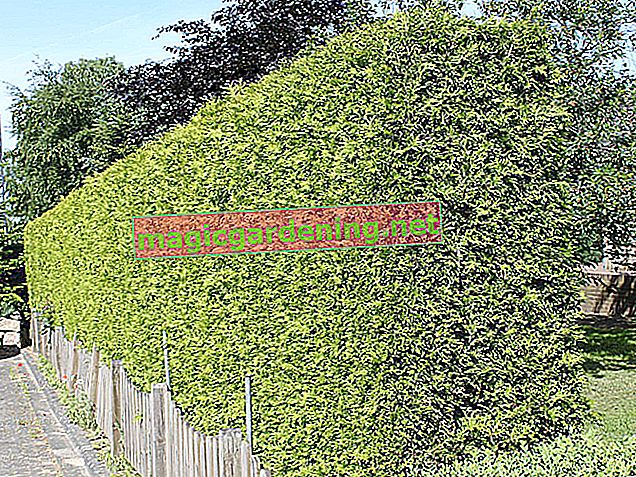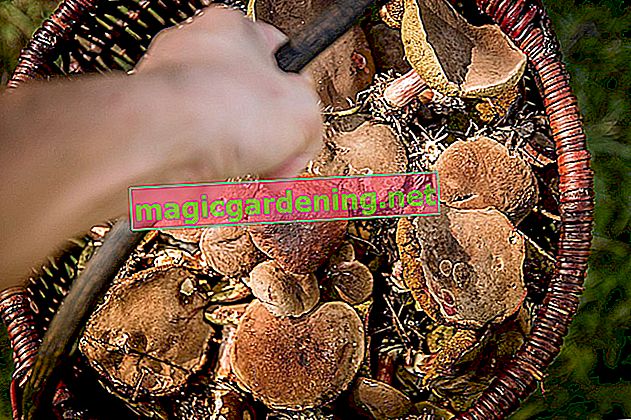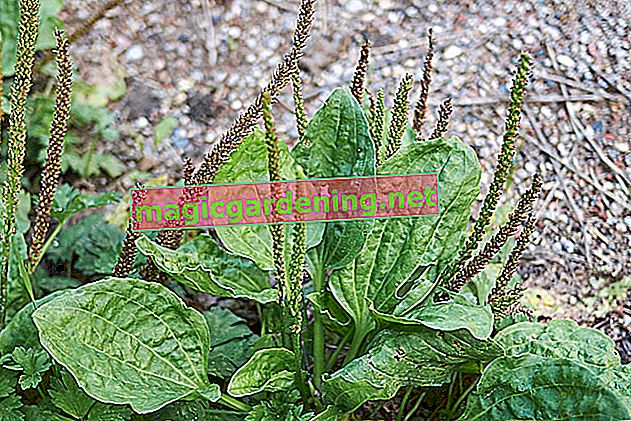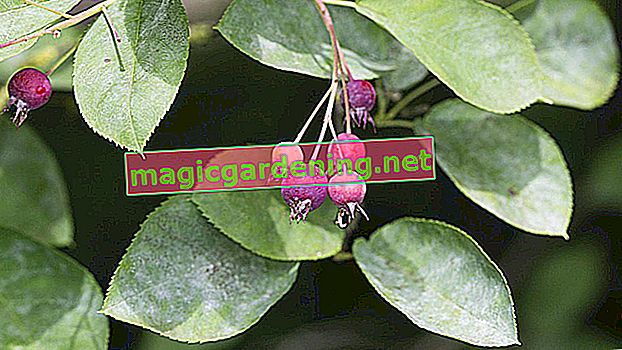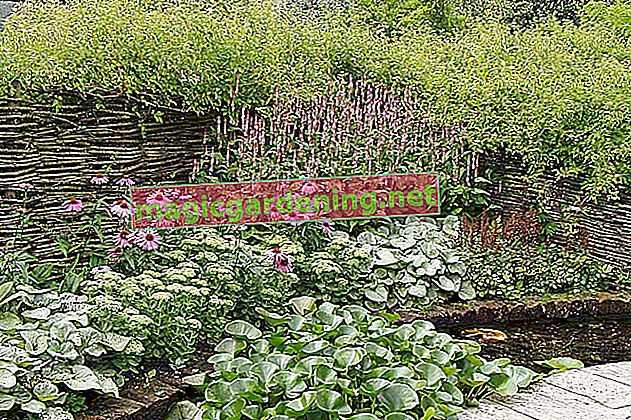
Origin and Distribution
Our garden hyacinths are of course not the original Hyacinthos plant, but instead are hybrid varieties that have emerged primarily from the wild Hyacinthus orientalis. It originally comes from the Mediterranean region and grows mainly in Syria, Turkey and Lebanon on rocky, barren ground and at mountainous heights of up to 2000 meters.
also read
- Maintain hyacinth in the house and garden for several years
- The hyacinth has faded - what now?
- How to care for the hyacinth in the pot when it has withered
The first plants came to Europe as early as the 16th century and quickly enjoyed great popularity, especially in aristocratic circles. Through breeding and selection, numerous new varieties in many colors were created within just 100 years.
use
Hyacinths are available in stores as early as January, with the flowers then being driven into special glasses or planters and starting to bloom as soon as they are bought.
In addition to keeping them in pots, bulbs are often planted in the garden, where they are among the first heralds of spring due to their early flowering.
Appearance and stature
Depending on the variety, hyacinths reach heights between 15 and 30 centimeters. Like all bulb flowers, they only have a short growing season, during which the first leaf tips are visible as early as February. A tuft of leaves develops from this, which in turn encloses the strong flower stem. The plant has already faded in July and is preparing to overwinter.
Hyacinth bulbs are perennial and sprout anew every year. They consist of individual scales that serve to supply and store nutrients. The onion keeps forming new scales from the inside, while the outer ones provide the energy for budding and flowering. So that you can admire the hyacinth blossom every year, the plants have to store more energy during the growing season than they actually need to bloom. Only then can new scales form. In contrast, the onion shrinks if the nutrient and water supply is insufficient.
leaves
Hyacinths form between four and seven ribbon-shaped, basal leaves that can be up to 30 centimeters long and two centimeters wide. They shine in a fresh, light green and envelop the flower stem that appears a little later.
Flowering and flowering period
Usually the flower stem sprouts together with the rosette-like leaves. The thick, fleshy stem grows to a height of 30 centimeters and bears a multitude of bell-like flowers that are arranged in a cluster. As a rule, only one flower stalk develops from each onion, very rarely there can be two. How many individual flowers there are on a hyacinth and how big the grape will be depends on the variety, the size of the bulb and the location and care conditions.
The intensely fragrant hyacinth blossoms can be admired from April to May and have an extremely wide range of colors: white, red, pink and orange, purple and even blue shades are available. There are also double-blooming and multi-colored varieties.
The individual flowers consist of three petals and three sepals that grow together and are mostly the same color.
fruit
Since hyacinths should be cut back after blooming in order to preserve the reserves of the onion, the flower rarely develops fruit.
But if you have overlooked a flower stem, you can use the seeds that ripen in it for sowing. Hyacinths are cloud coverers, the seeds of which must be sown immediately after the ripe fruit has disintegrated. They must not dry out, as in this case they lose their ability to germinate.
In nature, ants carry the seeds so that they germinate in the dark and warm environment of an ant burrow. Until then, however, it takes a very long time, because the seed first has to endure a warm phase during the summer months and then a cold stratification in winter. Only then is the inhibition of germination broken and the seeds sprout. However, you have to wait between three and five years for the first flowering.
Is garden hyacinth poisonous?
In addition to calcium oxalate, hyacinths contain other toxins that can cause skin irritation. Those who frequently handle the bulbs and flowers can get sick with the so-called hyacinth scabies. This manifests itself as redness, pustules and itching, but can also lead to severe inflammation. Onions and other parts of the plant should not be eaten, as they cause stomach and intestinal problems, including vomiting and diarrhea.
The plant is also toxic to animals: cats, dogs, horses as well as rodents (guinea pigs, hamsters, rabbits) and birds can suffer from more or less severe symptoms of poisoning when they eat plant and onion skins. Since the toxins irritate the mucous membranes, there is typically increased salivation and difficulty swallowing, including cramps, vomiting and diarrhea.
Which location is suitable?
The bulb flowers prefer a warm and sunny location. This should be protected from the elements such as cold and rain. You can cultivate hyacinths both in the garden bed and in pots or other planters on the balcony or terrace.
ground
Hyacinths like loose, mineral or humus-rich soil, which, however, should not be too moist. Good drainage is important so that the onions don't start to rot in the moist environment. To do this, you can, for example, put a layer of sand about five centimeters thick under the onions, which allows excessive moisture to seep away quickly.
Pot culture
The spring bloomer can be cultivated in small pots or planted in groups in larger planters, whereby you have to regularly supply the plants with water. The onion must not dry out, but also not stand too moist. Excess water should not remain in the planter or saucer, but should be removed immediately after watering. If the hyacinth roots are in the water for too long, they will rot, and with them the rest of the plant. Normal, commercially available potting soil, which you can mix with some coarse sand, is suitable as a substrate.
Cut off the faded flower stem. In contrast, leave the leaves to stand until they have turned yellow and are completely dry. Now put the pots with the onions in a cool, dark room, such as the cellar, and let them hibernate there until next spring.
Culture in a glass
Hyacinths have been cultivated in special glasses with a bulbous lower part and a curved upper shell for around 100 years. In such a hyacinth jar you only fill the lower part of the water, soil is not necessary. The onion lies in the upper shell and receives sufficient moisture without coming into direct contact with the water. The onion in the water glass must be placed in a dark and cool place for about two to three months, during which time you should refill with fresh water every day. Only when the flower stalk and leaves show up do you put the glass on the windowsill.
The disadvantage of this method, however, is that the hyacinth bulb cannot store any nutrients due to the lack of fertilization and therefore collapses after flowering and can no longer be used.
Plant garden hyacinth properly
First dig a planting hole, which should be about twice as deep as the onion is high. However, the minimum depth is ten centimeters. With heavy soils, put a layer of sand on the perforated soil, this will serve as drainage. Mix the excavated material with a good handful of compost and finally put the onion in the hole. The broad side should point down and the narrower side up. Now fill the soil into the planting hole and press it down lightly. Mark the spot with a bamboo stick or something similar so that you don't accidentally plant something else or even dig up the ground in the spring.
What is the best time to plant?
Place hyacinth bulbs in the garden bed on a mild, dry day between October and November.
The correct planting distance
There should be a distance of at least 15 centimeters to the neighboring plant.
Watering garden hyacinth
Hyacinths freshly planted in pots require little water and should therefore not be watered excessively. Only after budding does the water requirement increase somewhat. The right time to water again has come when the surface of the plant substrate has dried off. Never pour directly onto the onion, only all around.
Hyacinth bulbs planted in the garden, on the other hand, do not need to be watered at all, as the soil is usually sufficiently moist during spring.
Fertilize the garden hyacinth properly
You fertilize planted hyacinths in early spring with a little compost, while pot specimens are put into fresh substrate if possible.
Trimming garden hyacinth correctly
The fleshy flower stem should be removed after flowering in order to preserve the onion's nutrient reserves. However, do not remove the leaves immediately, but wait until they are yellow and dry. The flower bulb still pulls out the nutrients it contains, which is why cutting it away prematurely is unfavorable.
Oversummer / overwinter
As the hyacinth's vegetation phase ends in July, just leave the bulb alone after it has withered. Planted specimens can simply remain in the ground and are covered with spruce and fir branches or a thick layer of leaves in autumn. However, this protective layer must be removed from February / March as the flowers sprout early in the year. Alternatively, dig up the bulbs in summer, store them in a cool, dry and dark place, and put them back in the ground in autumn. Hyacinth bulbs are absolutely hardy as long as they are not grown in a pot.
Garden hyacinth propagate
Removing the faded hyacinth bulbs in summer has a great advantage: In this way you can separate the brood bulbs for propagation. In order for these to develop, however, the flowers need good location and care conditions in the form of sufficient water and a balanced supply of nutrients. You can encourage the mother onions to divide by making a deep cross-cut cut into the bulb base before planting in autumn.
Plant the small bulbs separately in autumn. The flowers that grow from it are initially rather small and sparse, but after about two to three years they bloom just as profusely as the mother plant. By the way, removing the brood onions is not only useful for propagation purposes, but also has advantages for the mother onion: This is deprived of many nutrients by the training of the daughters.
How do I transplant properly?
Transplanting to a new location is very easy: all you have to do is dig up the bulbs and replant them in their new location in autumn.
Diseases and pests
Like all bulb flowers, hyacinths are threatened by pests that live in the ground, such as voles. Above ground, snails and sucking insects such as aphids can especially be tasted of the juicy leaves.
In terms of diseases, mainly fungal infections occur, which show up in spring when budding. The gray mold caused by the botrytis fungus occurs very often, which is noticeable by brown spots on the stems and leaves. Infested plants should be removed immediately to avoid infection.
Choose a location that is not too humid and airy in order to avoid fungal diseases from the outset.
Tips
In the garden you should support the heavy flower clusters with a wooden stick or something similar, otherwise they tend to twist, especially after prolonged rainfall.
Species and varieties
The over 200 different varieties of garden hyacinths are mainly classified according to their flower colors. There are white, blue, purple, pink and orange, and red variants, with the purple and blue shades being the most common. The varieties 'Blue Jacket' (blue flowers), the white flowering 'Carnegie' and the 'Fondant' with their enchanting pink flowers are very popular. The purple-red flowering 'Woodstock', on the other hand, is one of the rare varieties and is therefore a particularly eye-catcher.
Varieties such as 'Crystal Palace' and 'General Koehler', on the other hand, have densely double, blue flowers, while the white splendor of 'Snow Crystal' is reminiscent of soft snowflakes. 'Prince of Love' and 'Hollyhock' have exceptionally salmon-pink flowers, with beautiful double, bright red flowers. Varieties with yellowish varieties such as 'Gipsy Queen' and 'Odysseus' are also very rare.
The different varieties develop very different inflorescences. Some impress with their very dense, large flower clusters, others are looser and more delicate. The so-called “multiflora” varieties, which always sprout several flower stems per bulb, are also an interesting eye-catcher. These include, for example, the blue 'Anastasia' and the pink 'Freestyler'. Multiflora hyacinths usually bloom with loose inflorescences that are less densely covered with individual flowers.



